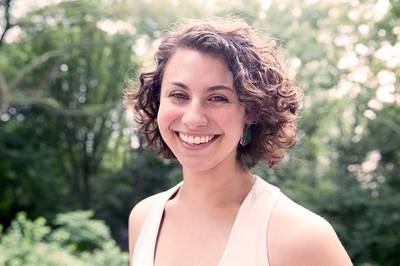 This is an interview with Maggie Cohen, a 500-hour advanced vinyasa yoga instructor and proud member of The Breathe Network, an international network of sliding scale, holistic practitioners who offer services for survivors of sexual violence. She is an instructor for Yoga Within Reach, a local organization in New York City, which has a partnership with Safe Horizon in Brooklyn, NY where Maggie teaches free, weekly classes for survivors of childhood abuse, sexual assault and domestic violence. Recently, she collaborated with Ilera, run by DeShannon Bowens, and Connect NYC to offer a workshop on vicarious trauma (a term coined in the 1990s in reference to experiences psychotherapists had working with trauma survivor clients). Soon she will be a guest on the podcast Sex for Smart People, which addresses sex education, relationships, and healing.
This is an interview with Maggie Cohen, a 500-hour advanced vinyasa yoga instructor and proud member of The Breathe Network, an international network of sliding scale, holistic practitioners who offer services for survivors of sexual violence. She is an instructor for Yoga Within Reach, a local organization in New York City, which has a partnership with Safe Horizon in Brooklyn, NY where Maggie teaches free, weekly classes for survivors of childhood abuse, sexual assault and domestic violence. Recently, she collaborated with Ilera, run by DeShannon Bowens, and Connect NYC to offer a workshop on vicarious trauma (a term coined in the 1990s in reference to experiences psychotherapists had working with trauma survivor clients). Soon she will be a guest on the podcast Sex for Smart People, which addresses sex education, relationships, and healing.
Rob: What originally motivated you to do this work, and what continues to motivate you? How, if at all, has that motivation changed over time?
Before I discovered trauma-sensitive yoga, I was living two separate lives, one as an activist and one as a yoga instructor. As I deepened my work with survivors of violence, it was clear that all of us carry our stories within our bodies. I became fascinated by how trauma affects the brain and how it manifests in the body. I realized that I could offer a more profound level of healing by fusing my passions and working from the "bottom up."
Is there a standout moment from your work with survivors of sexual trauma?
During my final class at Safe Horizon in 2013, one of my consistent students told me that she had been thinking about what makes my class different from others. She said, "I realized that it is safe for me to follow you. I always know that, wherever you take me, it is going to be okay. I guess I would call that... trust." This remains one of the most meaningful moments in my teaching.
What did you know about the population you are working with before you began teaching? What were some of the assumptions you had about this population, and how have those assumptions changed?
I've worked with survivors of violence for many years as an advocate and counselor, but I knew that offering yoga would be a different dynamic. I was surprised that my students' trauma does not define our classes. They are whole and thriving people with careers and education. They leave class and return to their families or friends and we walk out of class together onto the same subway. Their requests for the practice pertain to stress, backaches, the weather, which are the same subjects that come up in mainstream classes. We use the term "survivor" so casually these days, but it is also a powerful antidote to the myth that people who experience violence are defined by it. My students are survivors and, more, thrivers.
What are some of the things your students have taught you?
My students have taught me to be wholeheartedly myself in my teaching. I believe that all yoga teachers have felt like frauds at some point. The reality is, of course, that if I ask my students to bring their full selves to class, I must do the same. In Brené Brown's wise words, "Vulnerability sounds like truth and feels like courage. Truth and courage aren't always comfortable, but they're never weakness." My students demand this bravery from me with their vulnerability, joy, and compassion.
What has been the greatest challenge in your teaching experience, and what tools have you developed for addressing that challenge?
As a younger instructor in a burgeoning field, it's been challenging to gain confidence, to establish my niche in yoga teaching, and to trust my qualifications. I've had to practice combatting insecurity. I've also purified my intention so I know exactly why I teach, which I bring with me to every class, workshop, interview, and conversation. My mission is to heal and empower survivors of trauma, to educate other yoga instructors about trauma, and to make yoga more equitable and accessible.
What advice would you give to anyone who is going to teach in the population you work with?
I teach in conference rooms, or wherever my partner organizations have space, not in studios devoted to yoga. Therefore, I have to focus on creating rituals and safe space for my classes. Each week I tack up a board, inspired by my friend Zabie Khorakiwala, which says "Take What You Need," and lists words like "joy," "laughter" and "patience." My students collected these words throughout the series and it became just one of our ways to enter the space and begin our sacred practice. I could not have created this activity without support from a colleague. It helps to remember that we are not in this movement alone!
I'm interested to know how you think yoga teachers can foster greater trauma sensitivity.
This is a huge question, and one I am asked all the time! I hope to help mainstream yoga teachers understand some of the primary adjustments to make yoga more trauma-sensitive. I am organizing a pilot workshop for yoga teachers who teach public classes, which will go into more depth about how trauma manifests in the body, as well as modifications for our classes.
I believe that the first step for yoga teachers is acknowledging that there are survivors of trauma in our classes, even if the class isn't specifically for survivors of trauma. We prepare for students with injuries, depression, and pregnancies, yet we rarely discuss the possibility of students struggling with traumatic memories and bodily experiences. Second, we should strive to have clear and realistic intentions. We are not responsible for preventing every possible trigger, for "fixing" our students, or for reading their minds. I do not know my students' histories, and I prefer it that way. This clean slate prevents me from making assumptions about what triggers them or what they can or cannot do. Instead, I return to what I know, which is my intention to create a safe, empowering and healing environment for all of my students, regardless of their histories.
What are some of your ideas about or hopes for the future of "service yoga" in America in the next decade?
My deepest wish is that "service yoga" moves away from the model of powerful donor and underserved recipient. While service yoga is critical, it is often the only avenue for marginalized populations to participate in mindfulness practices. I envision all of yoga becoming more accessible racially, socioeconomically, educationally, for varying physical and mental ability, for varying gender and sexual orientations, and for survivors of trauma.
Editor: Alice Trembour
Stay connected with Give Back Yoga Foundation as we share the gift of yoga with the world, one person at a time, by following us on Facebook, Twitter and Google+ and by subscribing to our newsletter.
Are you a yoga instructor giving back to underserved populations? E-mail Executive Director Rob Schware if you're interested in being interviewed for this series. Thanks for all that you do in the name of service!
Need help? In the U.S., call 1-800-656-HOPE for the National Sexual Assault Hotline.
